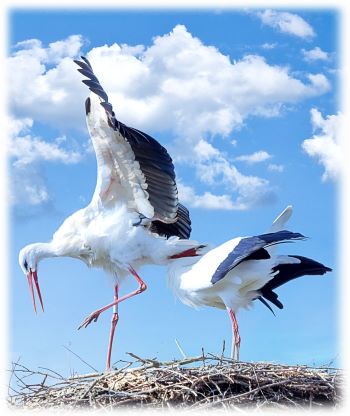Legend of Storks
Why are Storks associated with Babies?
Surely you must remember the big dreaded question children ask…
“Where do Babies come from?” And certainly you remember the cute silly answer: “Storks”.
For many centuries, storks have been associated with infant babies in various myths, legends, and fictional stories.
The stork’s association with babies is an ancient story. You can certainly find many pictures and images around the world where storks are seen carrying a baby wrapped in a cloth sack. These storks fly with their precious bundles carefully held in their beaks. The myth goes further to say that the stork later lands onto a doorstep to deliver the baby to the waiting parent(s). It is a simple legendary story that has been told to children for many, many years.
The legend of the storks association with babies is hard to trace just like most other ancient myths. More so, the myth historically can be traced to various countries ranging from North Africa, Europe, America, and the Middle East.

German Folklore
Storks are found in Europe in spring, and there are stories and beliefs (folklore) wrote many years ago about them. It is German folklore that stipulates that the stork got the mandate to bring babies to new parents using their beaks. It is ancient folklore, which was further popularized in the 19th century by Hans Christian Andersen through his book The Storks.
In this German folklore, it outlines how the storks found babies in marshes or caves picked up the babies using their beaks and delivered them to households wrapped in white clothes. It is a prevalent folklore tale that spread from German to the Philippines and other countries in South America.
There are several versions of this folklore, and all of them associated storks with babies. Yet another version of this story outlines that storks found the babies in caves referred to as Adeborsteines. In the German language, the term literally means stork’s stone. Adeborsteines is associated with the stones out of which babies probably “hatch.” It is a black and white stone that children used to throw over their heads to communicate with storks to inform them that they wish to have a new baby in their family. Adeborsteines were also the stones that mothers used to lay their babies upon to dry after taken from the sea.
This German folklore possibly spread over Europe due to the assumption and to deal with children awkward questions in regards to how the baby is born. Baby-making was especially a taboo subject in the time of Hans Christian Andersen. Up to date, the subject is not easy to discuss with children, and you have to find a story to tell of how a newborn baby came into the house. Since, many parents grew up hearing and reading these stork stories and find it easy to tell the tale to the children.
Greek Mythology
Another famous mythology that associated Storks with babies is Greek Mythology. The Greek myth, according to several accounts, features a revengeful goddess named Hera. As the story goes, Hera was not happy with a beautiful queen named Gerana, and thus she grew jealous of her and transformed the Queen into a stork. The stork in this mythology is associated with stealing babies for Hera the goodness first at bad intentions.
Later in the story, the Queen, who was transformed into a stork, tried to get back the child from Hera though still as a stork. It is one of the ancient mythologies which depicts a stork with a baby in its beak.
Paul Quinn’s Speculation
One of the well-known English Literature teacher Paul Quinn at the University of Chichester in the United Kingdom and an editor of a research journal on folklore and fairy tales try to explain the legend of storks with babies. He says that the association goes down to the connection between storks and children. European Medieval literature, he said, connects the stately white pelican with Catholicism, regeneration, and youth rearing. Storks may have become a replacement for that bird somewhere along the way.
No matter where each mythology originated from, all historians do come to a common agreement that storks deliver babies. Northern Europe, Norway, and German tend to believe in mythology firmly.
Migration Legend
Storks and babies can also be traced during their migration period, where they migrated from Europe to Africa. The medieval period, which is 600 years ago, was a pagan era. During this era, couples would hold their weddings at annual summer solstice due to believing that summer comes with fertility. Equally, it was the same period when storks used to start their migration journey flying all the way from Europe to Africa.
Coincidentally the storks used to return after nine months spring season and babies were born during that season in Europe. Storks also returned with their newborn chicks, and it led to the belief that storks were associated with the idea of delivering new human babies when returning from Africa. The complexity of this story grew over time and spread over Europe.
Norse Mythology
According to Rachel Warren-Chadd’s book, where she explains the Norse mythology, the stork we highly valued and regarded as a symbol of family values as well as purity. In Eastern Europe, Germany, and the Netherlands, storks used to nest on the roof of a household, and it was believed that it had brought good luck or delivering a new baby to the family
Despite that, Europe was the origin of the myth which also spread to America. Warren-Chadd says that she is amazed that the same story is told in Sioux legend but using a different type of stork, which is wood stork instead of white stork.
The story of Stork association with the babies was equally useful in Victorian England. The story was highly valued as it assisted explain the realities of sex as well as the birth of a baby. Warren-Chadd notes that it was hard for Victorians to disclose the facts of life, but through using the storks association with a baby, they were able to reach the point of prudishness.
In today’s world, Rachel Warren-Chadd denotes that childbirth is less pretentious. However, we employ the stork legend, be proud of a stork, and the role it plays in family life. She acknowledges that humans tend to humanize animals, and this has also helped with the legend of storks being associated with babies.
